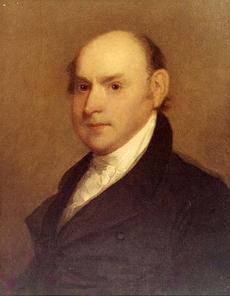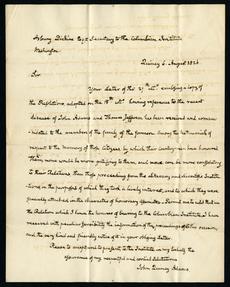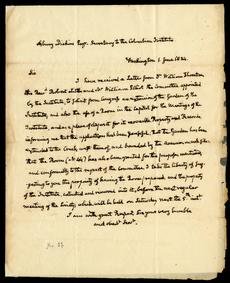 On June 1, 1824, someone wrote an anonymous letter to the members of the Columbian Institute, a literary and science institution in Washington, DC, regarding their need for a meeting room in the US Capitol building. Although there is nothing scandalous or mysterious about the contents of the letter, the handwriting is interesting and unique. As a conservation technician at the Smithsonian Institution Archives, my job is to go through each letter mending tears and preparing them for digitization, and while doing so, I have come across several letters from the 6th President of the United States, John Quincy Adams (1825-1829), that might shed light on who wrote the 1824 letter. In honor of President’s Day, I am excited to share with you our collection of letters from John Quincy Adams, and request your help in distinguishing his handwriting!
On June 1, 1824, someone wrote an anonymous letter to the members of the Columbian Institute, a literary and science institution in Washington, DC, regarding their need for a meeting room in the US Capitol building. Although there is nothing scandalous or mysterious about the contents of the letter, the handwriting is interesting and unique. As a conservation technician at the Smithsonian Institution Archives, my job is to go through each letter mending tears and preparing them for digitization, and while doing so, I have come across several letters from the 6th President of the United States, John Quincy Adams (1825-1829), that might shed light on who wrote the 1824 letter. In honor of President’s Day, I am excited to share with you our collection of letters from John Quincy Adams, and request your help in distinguishing his handwriting!
The Columbian Institute was created in 1816, and was composed of politicians, doctors, and scientists (including Adams), whose ideals of advancing the arts and sciences in the United States culminated in the building of the US Botanical Gardens. The organization dissolved in 1838 due to lack of funding and eventually was absorbed into the National Institute, whose records ended up in the Archives (for more information see the Archives’ finding aid for Record Unit 7051, Columbian Institute Records).
President Adams’ letters to the Columbian Institute were written during a contentious time in our political history, from 1822 through Adams’ term as President (1825–1829). According to the White House’s biography of John Quincy Adams, earlier political tradition would have made Adams the heir to the presidency, since he was Secretary of State. However, 1824 was a turning point in American politics when the country transitioned to electing the President by popular choice. Out of the four candidates that year, which included General Andrew Jackson, Henry Clay, William Crawford, and Adams, Jackson won the popular vote. However, since no candidate had a majority of electoral votes, the election was decided by the House of Representatives and Adams won out for a single term.
In order to find out who wrote the unsigned letter during this controversial election year, we can look to the discipline known as forensic document analysis, or the study of handwriting. According to experts, such as the American Society of Questioned Document Examiners, it is important to compare many samples of writing from the same author and examine the spacing between certain letters. As discussed in the article “How Forensic Handwriting Works” in Slate Magazine, it is also useful to examine the way letters and words are connected in each document. For example, in the cursive word “of”, how does the “o” connect to the “f”?
 For comparison, here are two letters written by John Quincy Adams (click on the letters to enlarge them). The letter dated August 6, 1826 was composed while he was President and visiting his father’s farm in Quincy, Massachusetts, where his father had died one month earlier. In the letter, Adams thanks the members of the Columbian Institute for their kindness while he mourned his father and Thomas Jefferson, both of whom died on July 4, 1826. I couldn’t help but notice John Quincy Adams’ careful penmanship and admire the small loops in the letters. They are unlike any of the other handwriting among the correspondence. The other letter we have from Adams was written in 1822, concerning his promotion to President of the Columbian Institute.
For comparison, here are two letters written by John Quincy Adams (click on the letters to enlarge them). The letter dated August 6, 1826 was composed while he was President and visiting his father’s farm in Quincy, Massachusetts, where his father had died one month earlier. In the letter, Adams thanks the members of the Columbian Institute for their kindness while he mourned his father and Thomas Jefferson, both of whom died on July 4, 1826. I couldn’t help but notice John Quincy Adams’ careful penmanship and admire the small loops in the letters. They are unlike any of the other handwriting among the correspondence. The other letter we have from Adams was written in 1822, concerning his promotion to President of the Columbian Institute.
Finally, here is the unsigned letter from June 1, 1824. It is written in a similar striking hand. What do you think? I am interested to hear if you think the handwriting matches.
Produced by the Smithsonian Institution Archives. For copyright questions, please see the Terms of Use.

Leave a Comment